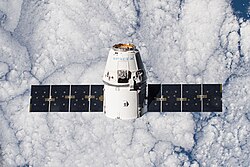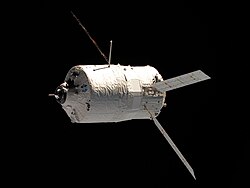HTV-3
| HTV-3 (こうのとり3号機) | |||
| Beställare | JAXA | ||
|---|---|---|---|
| Tillverkare | Mitsubishi | ||
| Modell | H-II Transfer Vehicle | ||
| Operatör | JAXA | ||
| Färdens tid | 55 dagar, 2 timmar | ||
| Massa | 19 000 kg | ||
| NSSDC-ID | 2012-038A[1] | ||
| Uppskjutning | |||
| Startplats | Tanegashima Space Center | ||
| Raket | H-IIB | ||
| Uppskjutning | 21 juli 2012, 02:06:18 UTC | ||
| Återinträde | |||
| Återinträde | 14 september 2012, 05:27 UTC | ||
| Omloppsbana | |||
| Apogeum | 305 km | ||
| Perigeum | 185 km | ||
| Banlutning | 51,6° | ||
| Varv | 859 st[2] | ||
| Dockning | |||
| Rymdstation | ISS | ||
| Greppad | 27 juli 2012, 12:23 UTC | ||
| Dockning | 27 juli 2012, 14:34 UTC | ||
| Dockningsport | Harmony Nadir | ||
| Ur dockning | 11 september 2012, 11:50 UTC | ||
| Släppt | 12 september 2012, 15:50 UTC | ||
| Kronologi | |||
| |||
HTV-3 eller Kounotori 3 (japanska: こうのとり3号機), var Japans tredje H-II Transfer Vehicle, uppskjutningen skede den 21 juli 2012, med en H-IIB raket. Ombord fanns bland annat förnödenheter, experiment och reservdelar. Farkosten anlände till Internationella rymdstationen den 27 juli och med hjälp av Canadarm2 dockades den med stationen. Farkosten lämnade stationen den 11 september 2012 och brann upp i jordens atmosfär den 14 september 2012.
Farkostens japanska namn kounotori betyder "amurstork" på japanska.
Källor
Fotnoter
- ^ ”NASA Space Science Data Coordinated Archive” (på engelska). NASA. https://nssdc.gsfc.nasa.gov/nmc/spacecraft/display.action?id=2012-038A. Läst 2 mars 2020.
- ^ Manned Astronautics - Figures & Facts Arkiverad 3 oktober 2015 hämtat från the Wayback Machine., läst 23 juli 2016.
| |||||||||||||
| ||||||||||||||||||||||||||||||||
| ||||||||||||||||
Media som används på denna webbplats
This image, photographed by one of the Expedition 42 crew members aboard the International Space Station, shows the SpaceX Dragon cargo craft approaching on Jan. 12 2015 for its grapple and berthing and the start of a month attached to the complex. Dragon carried more than 2 ½ tons of supplies and experiments to the station.
Backdropped by a blue and white part of Earth, the unpiloted Japanese H-II Transfer Vehicle (HTV) approaches the International Space Station.
ISS021-E-017623 (30 Oct. 2009) --- Backdropped by a cloud-covered part of Earth, the unpiloted Japanese H-II Transfer Vehicle (HTV), filled with trash and unneeded items, departs from the International Space Station. European Space Agency astronaut Frank De Winne, Expedition 21 commander; NASA astronaut Nicole Stott and Canadian Space Agency astronaut Robert Thirsk, both flight engineers, used the station's Canadarm2 robotic arm to grab the HTV cargo craft and unberth it from the Harmony node's nadir port. The HTV was successfully unberthed at 10:18 a.m. (CDT) on Oct. 30, 2009, and released from the station's Canadarm2 at 12:32 p.m.
A Progress supply ship linked up to the orbiting International Space Station (ISS) at 3:48 GMT, November 18, bringing Expedition 1 commander William M. Shepherd, pilot Yuri P.
Gidzenko and flight engineer Sergei K. Krikalev two tons of food, clothing, hardware and holiday gifts from their families. The photograph was taken with a 35mm camera and the film was later handed over to the STS-97 crew members
for return to Earth and subsequent processing.Backdropped by a cloud-covered part of Earth, the Orbital Sciences' Cygnus cargo craft approaches the International Space Station, photographed by an Expedition 40 crew member. The two spacecraft converged at 6:36 a.m. (EDT) on July 16, 2014.
ISS026-E-037172 (24 Feb. 2011) --- Surrounded by the blackness of space, the European Space Agency's "Johannes Kepler" Automated Transfer Vehicle-2 (ATV-2) approaches the International Space Station. Docking of the two spacecraft occurred at 10:59 a.m. (EST) on Feb. 24, 2011.











